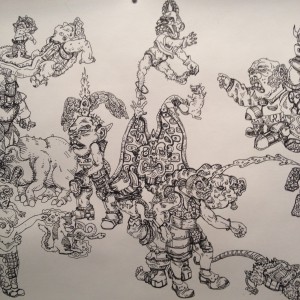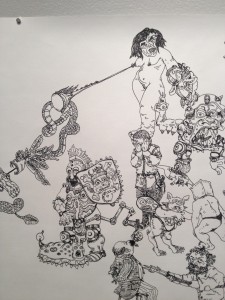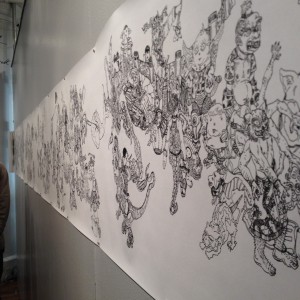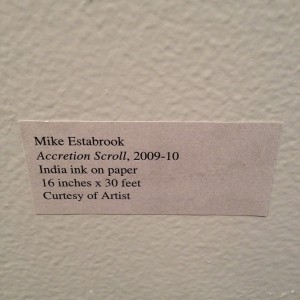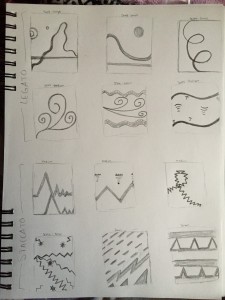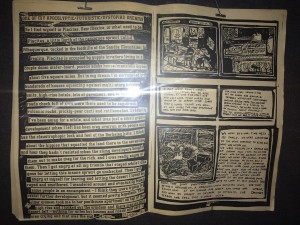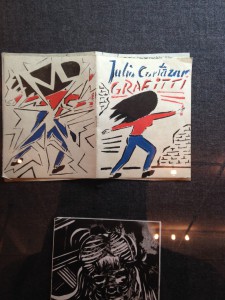On our last course, we had a field trip which was really cool. Especially the Center for Book Arts! I really like the 30 feet long comic painting called Accretion Scroll, by Mike Estabrook which is super genius! It caught my attention at all. I’ve “read” it from the left to the right and I was trying to find out the order of his painting, but that was so hard. Standing in front of the work with a distance, the picture shows a clear contrast between black and white. When I stepped in, there’s really a mass!But when I watched it much closer, I noticed there are plenty of stories which are connected! It was like people are on the way working, or a corner of a supermarket, or a super great war place of a star war! This painting is so fabulous which makes me think of thousands of ideas, they just jump out of my mind!
Art works are always a good communicating tool to express what you want to say!
Monthly Archives: September 2014
Project #2: Research Location
Starting my walk today I went around City Tech with no actual plans to where I wanted to go since I don’t really know the area as well as I would like to, that being said let me describe my tiny adventure around Jay Street! First off exit from the Johnson Street side, the one with the construction going on as you walk towards this street you’ll be greeted with sounds of cars, trains and indistinguishable voices. Now keep on going after a bit of minutes of walking you can look to your left and see a concession stand with people waiting on line to get some food you’ll also be able to see or take the subway if you desire. As you might see there is some trees and much leaves go through there, as you walk you will come across people being people and enjoying the day. Now keep on going and you’ll see a Five Guys, now why a Five Guys? I was hungry that’s why. Now make a right you should be able to see many buildings out into the distance also if you look to your left there will be a nifty map to help you out in case you are ever to get lost. Now keep walking and go past the metal poles and keep on walking you’ll come across a blood donor center in which you can go donate blood to save a few lives. Now here is one of the instances I see in which I see two New York’s the building behind the small one makes it look as if a line that divides the newer and more nicer looking building from the ones that are more run down and have more history behind them. As you keep walking north the divide becomes more evident the buildings aren’t as nice looking as they were around City Tech, once you pass the ASA learning center look to the sky and to look at a towering building that in a sense makes it look as this area is closed in similar to an oasis in the desert, only that in this case the desert is the newer Jay Street and Willoughby Street is the oasis in the desert. Now walk north towards Willoughby Street and keep walking north till you come across Lawrence Street make a left and you’re in the Fulton Mall. Keep on walking north and you’ll be greeted by various noise ranging from people to buses along with the many noises you might also be greeted with delicious smells depending on your tastes, I found it rather delicious but then again I was hungry. Now as you walk you will eventually come across Bridge Street make a left and see another entrance to the train station this time it’s the 2 and 3 lines ignore this for now or take it if you’d like. As you walk you’ll see a building that is currently under construction and along with that building there is many noises from industrial equipment. For our last stop keep on going straight and take the R train lines.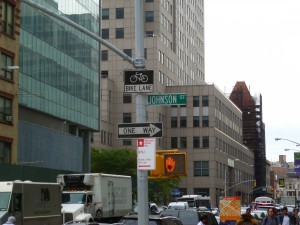
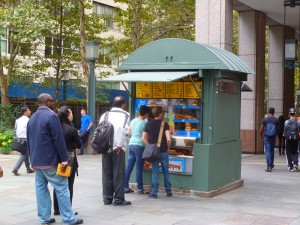
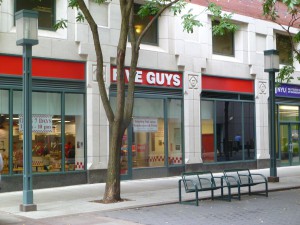
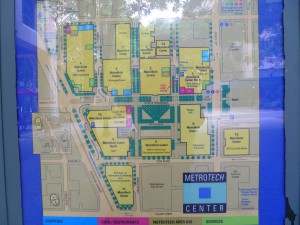
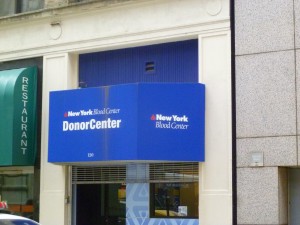
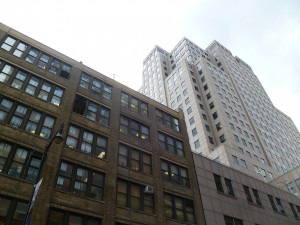
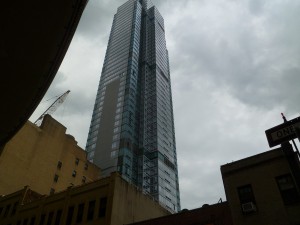
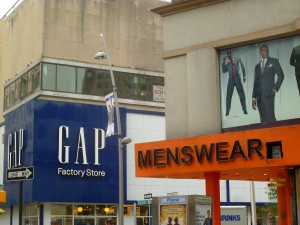
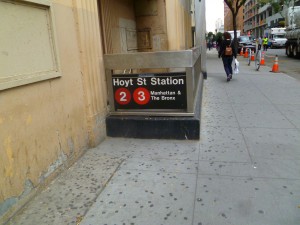 , and now where? Well for me it’s home and that was my adventure around the neighborhood that surrounds City Tech.
, and now where? Well for me it’s home and that was my adventure around the neighborhood that surrounds City Tech.
Opening tonight: City Tech students’ work at BHS
Join me tonight from 6-8:00 for a great opportunity to go to the opening of Wonder: First Encounters with Green-Wood, a photography exhibit at Brooklyn Historical Society featuring work by your ADGA classmates! You can read more about this on the City Tech website, the CUNY Events Calendar, and BHS’s website.
If you are interested in attending the opening, please let me know either via email, OpenLab message, or by replying to this post. I can give you directions for you to meet me at BHS or can meet you at City Tech beforehand and we can walk there together. If you’re interested but can’t make it tonight, the exhibit will run through January 15th, so you can go on your own or with some classmates. We’re planning a field trip to BHS this semester, but I don’t know that we’ll have a chance to see the exhibit then.
***If you attend and write a blog post about the show–at least 300 words–you will earn extra credit that can be applied wherever needed in your ENG 1101 grade.***
Thumbnails : Legato & Staccato
Aural Topographies: Research
It was hard for me to draw what I hear in some songs that I enjoy, but I finally found one that’s more smooth and soothing by Celine Dion. Her voice and the music helped me visual picture more. At first I can see wavy and soft lines and small hills forming when she hits her soft high note. The sound does have the same beat and the pattern doesn’t change as she sings with the music.
As I said before, the soft wavy lines are short and more expanded as the music plays in the beginning of the song. Then gets longer with the waves becoming closer together, but not sharp at all. Also, solid lines when things become silent. When the music picks up, not too loud, there are medium sized circles in the middle of the picture. That represents the bass or the drums. As the music fades at the end, the lines fades as well. It’s more of a Legato song.
City Limits: Summary
“City Limits” by Colson Whitehead is a interesting article that tells readers about different views of New York and how everyone see’s it differently. In the article, Whitehead explains how New York life was for him, and how he see’s New York compared to everyone else. He begins by telling readers what he knows New York to be in his perspective, for example, in paragraph four, he explains his first time building his New York when he was looking out a subway window on the 1 train, describing the area as filthy, and to him, that’s how he will always portray that area, since that’s the way he saw it. He also shows this further on into the paragraph as he begins to describe the Met Life building next to the Grand central station as the Pan Am building since that’s the way he first saw it, compared to a woman that refers it as the Met Life building. Both contradict each other, saying that the other one is wrong and they are right, but in the end, it all depends on how the person first saw the building in their perspective.
Throughout the rest of the article, Whitehead exclaims that everyone’s new York will always be their own personal New York, but there will be times where people will begin to refigure their New York as time moves along, telling readers that you should try to accept the new compared to the old, not trying to judge it just because its different. But no matter what happens, the building you have grown to accept, will still be your own memory of what the building used to be to you in your own personal New York. It’s as if our own New York is like our own Utopia, a happy place that we can go back to remember and wish that we can relive again if given the chance. Its that sense of nostalgia that makes us sad at first, but happy to know that we once knew of such a place when we first saw it. For example, I remember when I was younger, the Nintendo world building in Rockefeller center in time square, wasn’t always Nintendo world, to me, I saw the Pokémon center. It was a building that was dedicated to such a big franchise that was, and still is successful to this day. now, instead of the building being dedicated to the one game, it has its own corner of glory on the top floor of the building, along with other Nintendo titles. However, the building still has the original doors from the old building, retaining its history and nostalgia for most people. To me, that building will always be the Pokémon center in my personal New York.
Project 2 Research: Location
My location around CityTech goes from an immediate left turn when you come out of the main doors all the way down to the construction sites. I chose this location because it shows the less busy areas and the new upcoming ‘New York’. I feel that this could provide a perfect example of old and new. Not everything was fancy or official. There was definitely more fast food restaurants and other food places. when you keep walking down at least 2-3 blocks you should be able to see a large trench like structure in the ground due to construction
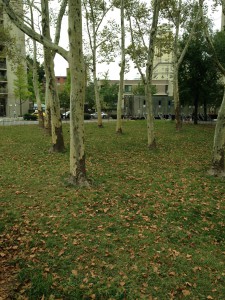
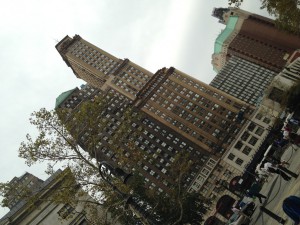
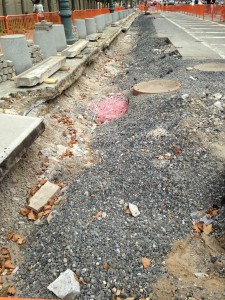
Field Trip!
Last week Monday, our class field trip to the Center for Book Arts gave me an insight into the art or zines and print making. I was awestruck at all the illustrations I saw on the walls and on display. A lot of the zines came with personal stories that I was actually able to relate to. In the above image, the narrator talks about her experience going back to their old hometown and dealing with the harsh reality of gentrification. This made me reflect on my own experiences with gentrification and I felt as though my feelings relatedly wholly to the narrator when they expressed anger towards themselves, and the situation going on.
After the Center for Book arts, we went to the Ruben museum to view the artwork of Francisco Cervelli. A lot of his works were a struggle for me to interpret as some images would be duplicated and have their colors swapped. For one piece, there were birds with arrows. When the color scheme was blue and gold, I felt as though it reprinted a death of pride. When the color scheme was red and white, I found elements of innocence. This just shows me how much detail goes into a piece to affect the viewers mind.
Field Trip (Book arts and Rubin Museum)
In English 1101 our First field trip we traveled to a museum and a exhibit by taking the R train. At first I thought the atmosphere was weird and kinda cluttered, But as I walked around and observed my surroundings I realized that this is a prime example of Not to judge a book by its cover. When I looked over many peoples work I felt the emotions that they felt while creating their zines and the message that they was sending. The artists really wanted to connect with others, and are everyday people like us. I honestly felt the tour was really short and brief I actually wanted more. While in the Rubin Museum I felt more comfortable and gained a lot more historical knowledge while In a better artists perspective. I would say the Rubin Museum really likes to show the roots of their origin or their foundation because I felt a very strong history lesson coming along while I see repeated pictures but with swapped or different colors, showing us a different meaning. The image i chosen was a lady with vines all around her.This image caught my eye immediately and I stared for a while because It reminded me about nature in a sense and it was overall very appealing to my interests in life. Overall I enjoyed it and hope to have more.
City Limits Reflection
In the reading of Colson Whitehead’s “City Limits” we learn a lot about our own view of New York. We’re all New Yorkers when we see a building or area of New York and we can remember what has been there before. Everyone has their New York. In the second paragraph he talks about that and how everyone starts to build their own New York once they make memories from what they see or remember. He also goes on about telling us not to believe what we hear or read on TV, newspapers, etc that’s about New York’s history. He says it doesn’t matter in what our New York is. While reading this you might even feel really nostalgic over some of the things that it makes you think. We may have seen a store change to several different things over the years. He also explains that we never really get to say goodbye to those places that we go to because we never know when it’s the last time we will be there.
Towards the last few paragraphs he talks more about as being a New Yorker, we can remember the past and see changes. But he also explains that no matter what New York will constantly be changing, with or without us. We can eventually see an entirely new city compared to what’s been there in the past. However, that will always be our New York.
